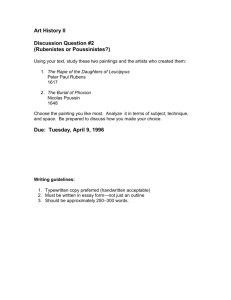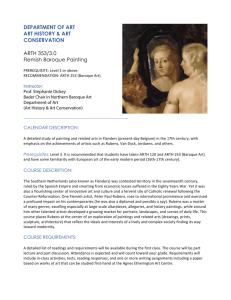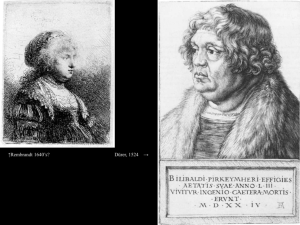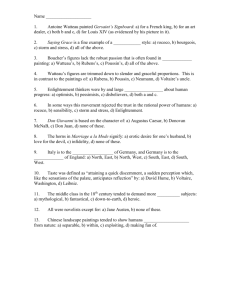Sexual selection and speciation: field crickets as a model system
advertisement
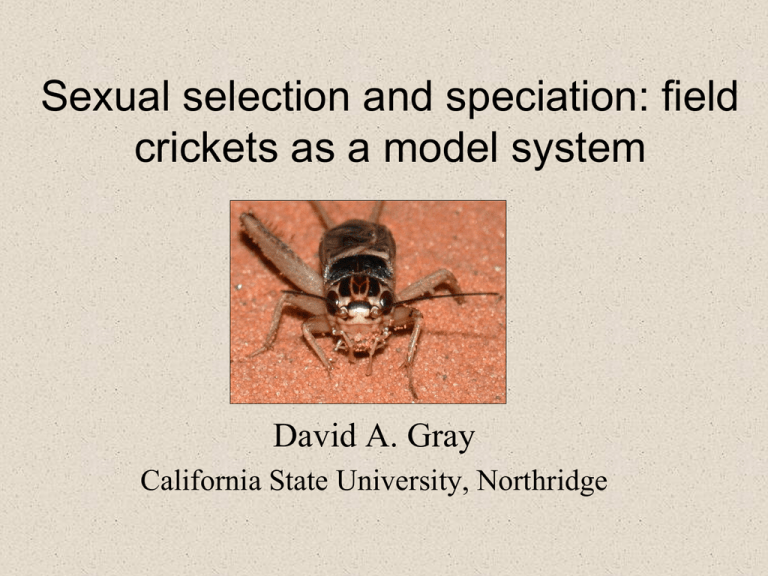
Sexual selection and speciation: field crickets as a model system David A. Gray California State University, Northridge The Cricket Mating System Cryptic sister species: Gryllus texensis and Gryllus rubens Geographic Ranges Male pulse rates (field matings, N = 451) 70 60 50 40 30 20 10 0 45 50 55 60 65 70 pulse rate @ 25 C 75 80 85 90 95 Lab hybrid songs Quantitative genetics: G. texensis • ‘Meta-population’ heritability – Male song h2 = 0.40 + 0.16 * – Female preference h2 = 0.38 + 0.17 * • Genetic correlation – rG = 0.49 + 0.23 * • * Estimates greater than zero. Courtship as a pre-mating isolating mechanism? • Geographic variation in courtship • Sound and Smell – Muted males – Song playback 568 trials completed…… Males Exact, P1-tailed < 0.000). 90 80 Percent Male Courtship G. rubens (Fisher’s G. rubens 100 G. texensis (Fisher’s 70 60 Cons pecific female Heteros pecific female 50 40 30 20 10 0 Allopatry Exact, P1-tailed = 0.073) Allo/Sym NS Sy mpatry G. texensis 100 90 Percent Male Courtship 80 70 60 Cons pecific female Heteros pecific female 50 40 30 20 10 0 Allopatry Sy mpatry Species of Male:(Fisher’s Exact, G. rubens P1-tailed = 0.028, G. texensis P1-tailed = 0.000) % fem ales mou nting Females 80 60 20 0 G. rubens male G. tex ensis male G. rubens male G. tex ensis male G. rubens s ong G. rubens s ong G. tex ensis song G. tex ensis song G. texensis females 100 % fem al es mo untin g Allo/Sym NS Allopatry Sy mpatry 40 Courtship song played: (Fisher’s Exact, G. rubens P1-tailed = 0.000, G. texensis P1-tailed = 0.000) G. rubens females 100 80 60 Allopatry Sy mpatry 40 20 0 G. rubens male G. tex ensis male G. rubens male G. tex ensis male G. rubens s ong G. rubens s ong G. tex ensis song G. tex ensis song M ale Son g and Species Combination Questions answerable (?) with DNA sequence data • Extent of recent hybridization • Population history (expansion, isolation by distance) • Geographic context of speciation • DATA 177 G. rubens from 25 localities 188 G. texensis from 23 localities 724 bp mtDNA Cytochrome C Oxidase subunit I (COI) • G. texensis 164 haplotypes (N = 188) • G. rubens 27 haplotypes (N = 177) AMOVA Between species 10.22% P < 0.0001 Other Results • No evidence of significant hybridization • G. texensis – No geographic isolation by distance – No recent population expansion • G. rubens – Recent population expansion (P < 0.02) – Geographic expansion with significant isolation by distance (P < 0.02) Geographic scenario, per DNA G. rubens and G. texensis summary • Behavior/Morphology: – Species divergent in male song and female preference – Males not divergent in other traits, can form viable hybrids – Females divergent in ovipositor length • Quantitative genetics: – fast runaway co-evolution possible • Molecular genetics: – G. rubens evolved recently from within an isolated subset of G. texensis Current Work Does reproductive isolation evolve proportional to time (gradualist model of evolution) or proportional to speciation events (punctuated equilibrium model) and does it matter if the taxa are allopatric or sympatric? • Modest Goals: – Describe speciation in Gryllus – Describe song evolution in Gryllus – See how they are related • Problems: – Most species of Gryllus in the western US and Mexico undescribed – Phylogenetic relationships unknown Fieldwork: 2003- 2008 Camping: • With Classes: 70 nights, 1150 student-nights • 247 nights total G1 4 4 ru b e n GrF 1 5 8 GrF 2 2 7 GrF 2 2 6 GrF 1 2 1 Gtd 6 8 6 Gtd 1 0 2 Gtd 1 0 4 2 G3 1 v e rn a l G3 3 v e rn a l G1 5 0 Gc h i r G. rubens G. texensis G1 5 1 Gc h i r G1 4 3 ru b e n G1 3 7 ru b e n G1 8 2 OEC AN G1 0 1 Gc o h n Grf1 5 1 GrF 2 5 1 GrF 2 4 8 GrF 2 1 1 GrF 2 1 0 GrF 1 6 9 GrF 1 6 8 ‘oecanthus’ G. cohni ‘yucca’ GrF 1 2 2 Grd 4 3 7 Grd 4 0 5 Gtd 5 7 Gtd 6 7 9 Gtd 1 1 0 0 G1 6 5 y u c c a G1 0 2 Gc o h n ‘sp. 2’ 2 Gs p 2 T o n o 5 Gs p 2 T o n o G5 6 GRe n o G5 7 GRe n o Gryllus phylogenetics, about 1500 sequences so far ‘mojave’ G1 4 6 Gl a v a 2 8 9 Ch i ri c 3 1 1 Ch i ri c 2 0 D e e rC d r 2 2 D e e rC d r 2 3 D e e rC d r 2 1 D e e rC d r 19L am o ill ‘sp. 11’ 7 Gs p 2 T o n o 6 Gs p 2 T o n o 4 Gs p 2 T o n o G1 4 Gs p 2 ‘sp. 13’ G8 G s p 2 G5 5 GRe n o G1 8 m o j a v e G1 7 m o j a v e W G 1 7 Ap a c h W G 1 6 Ap a c h 0 4 1 1 2 S ED G1 4 7 Gl a v a G. alogus G8 4 Gs p 1 1 G5 4 Gs p 1 1 G5 3 Gs p 1 1 04 117m ad 0 4 2 b u rr o G1 0 3 Gs p 1 3 G1 0 4 Gs p 1 3 G1 6 4 Gs p 1 3 G1 8 5 Gs p 1 3 G1 6 3 Gs p 1 3 1 7 4 G3 p 2 c 2 1 7 3 G3 p 3 c 2 ‘sp. 10’ G. vocalis 307 alog us G1 5 3 a l o g u G1 5 2 a l o g u ‘california veletis’ W G1 0 v o c a l 0 4 9 0 Aft o G9 8 Gs p 1 0 G9 7 Gs p 1 0 ‘arizona stutter-triller’ G9 6 Gs p 1 0 G1 6 Gs p 1 0 G2 0 v o c a l i G1 9 v o c a l i G2 3 v o c a l i G1 3 v o c a l i W G1 2 v o c a l W G1 1 v o c a l 0 4 9 2 Aft o G1 5 4 i n te r G. brevicaudus G2 0 1 v e l e t G5 0 v e l e ti ‘sp. 15’ G2 0 3 v e l e t G1 1 v e l e ti G1 2 v e l e ti G9 v e l e ti s G2 0 2 v e l e t G1 0 v e l e ti 2 9 5 AAZ s tu 2 9 5 BAZ s tu G. lineaticeps 2 9 4 AZ s t u t G4 b re v i c a W G 9 Ca rr i z G6 b re v i c a G5 b re v i c a G1 1 9 Gc h i r G. pennsylvanicus 0 4 4 Gs p 1 5 2 9 1 G6 p 3 c 8 ‘grass’ 2 9 3 Gs p 1 5 2 7 8 Gs p 1 5 3 0 5 Gs p 1 5 2 7 9 Gs p 1 5 G1 l i n e a t i G8 9 l i n e a t G2 2 l i n e a t NCB Ip e n n s UT M 3 p e n n UT M 1 p e n n G4 0 p e n n s y G9 0 g ra s s G9 5 g ra s s G9 2 g ra s s W G5 o v i s o p W G 3 fi rm u s G. ovisopis G. firmus G6 2 fi rm u s G6 1 fi rm u s W G 4 fi rm u s G6 0 fi rm u s ‘insularis’ G1 1 8 Gtri l G1 1 1 G3 p c G1 2 2 g ry l l G1 5 8 Gp e c o ‘roadside’ G1 5 9 Gp e c o G1 5 5 i n te r 1 7 8 ro a d s i G1 5 7 ro a d s ‘pecos’ G6 8 M tPa s s G7 8 M tPa s s G7 7 M tPa s s G1 7 9 Gc h i r G1 8 0 Gc h i r 2 9 B BCh i rp 3 0 B BCh i rp 2 5 D e e rC ri G1 4 2 fa s tc G3 0 v e l e ti 1 8 3 Gu a d a l 1 8 9 Gu a d a l 1 8 1 Gu a d a l G6 3 c h i rp e 1 8 6 Gu a d a l G2 6 v e rn a l ‘mtn. pass’ G. veletis G2 7 v e rn a l G3 8 fu l to n G3 6 v e l e ti W G 1 5 Ru b y M W G 1 4 Ru b y M W G 8 v e l e ti W G1 3 v e l e t G2 9 v e l e ti G3 7 v e l e ti G3 9 v e l e ti G2 8 v e rn a l 0 4 4 4 p a rk 0 4 5 0 PA RK 0 4 4 7 PA RK 0 4 4 5 p a rk 04 118m ad G3 2 fu l to n ‘guadalupe veletis’ G. vernalis G. fultoni ‘parker cyn/Madera G.’ G3 4 fu l to n G3 5 fu l to n 3 1 2 i n te g e 3 8 i n te g e r 2 8 i n te g e r 4 2 i n te g e r ‘rock’ 4 1 i n te g e r 3 9 i n te g e r G5 8 i n te g e G5 9 i n te g e G5 1 i n te g e G7 2 i n te g e G7 3 i n te g e 2 1 8 i n te g e G9 1 i n te g e G7 0 i n te g e G. integer 2 8 1 i n te g e 2 1 1 i n te g e ‘integer’ 1 7 5 i n te g e 1 6 9 i n te g e 1 7 2 i n te g e 1 7 1 i n te g e 2 3 3 i n te g e ‘integer’ 2 1 4 i n te g e G8 3 i n te g e G8 6 i n te g e 04 108n ee G1 2 6 Gb l k c ‘integer’ G1 2 7 Gb l k c G1 9 9 h i l l s G6 7 ro c k y G1 6 2 Gb a g g G6 9 G3 p c G1 3 4 Gs p 2 9 ‘rocky’ G1 6 1 Gs p 2 9 G2 0 0 h i l l s G1 0 0 Gre d G9 9 Gre d G1 9 8 Gc h i r G1 9 7 Gc h i r 3 2 6 p e rs o n 3 2 4 p e rs o n ‘baggeti’ 3 2 1 p e rs o n 3 3 0 p e rs o n G7 5 p e rs o n 3 2 5 p e rs o n ‘sp. 29’ 3 2 8 p e rs o n G7 6 p e rs o n G1 9 4 s wa m p G1 9 3 s wa m p G8 8 a s s i m T G1 0 9 s l o wc G1 1 2 Gs p 1 G1 1 3 Gs p 1 G. personatus G1 2 9 a s s i m G4 7 a s s i m W G4 6 a s s i m W G8 2 a s s i m T ‘island’ G6 5 a s s i m T G6 4 a s s i m T G2 4 a s s i m E G2 5 a s s i m E W G1 a s s i m E ‘multipulsator’ W G2 a s s i m E G2 a s s i m W W G 6 Yu m a AZ W G 7 Yu m a AZ G3 a s s i m W G2 1 a s s i m W 04 100o ax G1 1 5 Gs p 1 W G2 2 b i m a c W G2 3 b i m a c 1 G. assimilis Example Tree • Two Speciation matrices A B C – One based on genetic distance – One based on #’s of nodes (speciation events) D E F G H I J Genetic Distance Gallup Big Black Chirper Utah “integer” Arizona Stutter-triller species 13 Multivariate Song Distance Pulses per burst Frequency Pulse Rate Bursts per unit song Song and Speciation • Matrix of ‘song space’ distances • Matrix of genetic distances • Matrix of nodal distances • Covariate matrix of Sympatry/Allopatry

